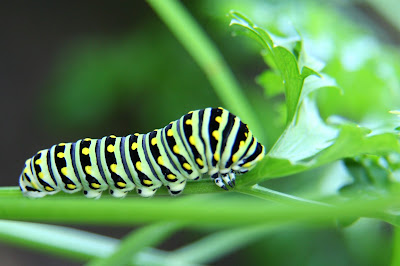Some of my favorite summertime garden visitors are the hummingbirds. I had at least one male and one female that I would see constantly in the garden, flying from flower to flower. They especially loved the red Cardinal Climber and red Texas Sage this year. They never seemed to visit the hummingbird feeder that was in the flower garden, so I decided to move it close to the back porch where there are less flowers and where I could see them better if they decided to visit. It worked! They would visit several times a day. It took them a little while to get used to me and my two cats on the back porch, but they warmed up to us. I spent a lot of time sitting out there with my zoom lens on my camera and finally got an ok shot of the male hummingbird.
Butterflies are a constant presence in the garden during summer days. Usually it’s Cabbage Whites and Tiger Swallowtails. I sometimes get others, such as Skippers, Eastern Black Swallowtails, Monarchs, and recently a Fritillary. I found myself wishing this particular Tiger Swallowtail could tell me his story. He looked like he had been through the ringer with frayed wing edges and that big missing piece.
The past couple of years I have found Eastern Black Swallowtail caterpillars on my Parsley. Parsley is a host plant for these swallowtails. The butterflies lay their eggs on the plants, then the caterpillars eat and eat until they are ready to make chrysalises and become butterflies themselves. I had at least two of the caterpillars this year. It has gotten to the point that I don’t cut parsley to use it until I look under the leaves for eggs first! I have definitely found them.
Bees are my friends. I found myself going out into the garden every day just to check on my bees. I get a lot of native bumble bees. This year I actually saw some honey bees, which is not as common.
Another buzzing visitor this year was Digger Wasps. I don’t recall having seen them before. I think it might mean I have grubs, which I actually already knew. Females burrow into the ground looking for white grubs, stings them, and lays eggs on the them. The larvae pupates and overwinters in a cocoon within the host’s body. Gross, huh?
I see praying mantises every year, however, this year they have been particularly plentiful. I often see them near the back door, so I think they must live in the mint or other herb beds that I have there.
They are so alien-like. Such fascinating creatures.
I get many different birds in the garden. My favorite birds are the goldfinches. They are happiest when the purple coneflowers are loosing their petals. That is when the finches get the seeds. This year I tried hanging a finch sock near the back porch to see if I could watch the finches like I get to watch the hummingbirds. It worked! I get to see lots of finches up close now, as long as I sit still and as long as the cats behave and don’t try to jump at the screen. I get lots of females, but have only seen two males this year.
If you look carefully, you will spot a bluejay in the next photo. There were more bluejays than usual this summer. For awhile each morning I would witness two bluejay parents teaching their fledglings to fly. They would go from tree to shrub to tree, following each other. They were a noisy bunch.
Hard to see in this shot, but there is the bluejay on the left by the bird feeder and one of the neighbor’s cats, Tiger, on the right. My neighbor has at least four cats that visit the garden, three of them more regularly. It is rare for me to be out there and NOT see a cat. The three regular visitors are all orange and white.
Here Tiger has spotted one of the Tiger Swallowtails. Hmmmm, maybe that is how the one lost part of his wing.
Puss loves to nap in the garden. I have to be careful because there have been times when I have almost stepped on her or almost weeded her! Somehow she finds the gravel path comfortable. Not sure what that is all about.
There are many other creatures of the garden, these are just the ones that I happened to have gotten close enough to take pictures of! I love that my garden is welcoming to other creatures. After all, it is just as much for them as it is for me.

































































